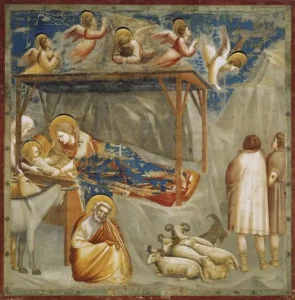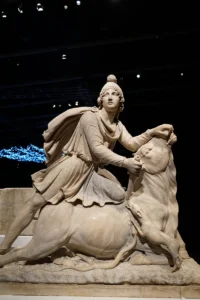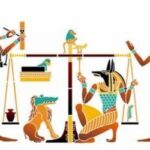December 24, 2024 Hidden history
Many of these gods, once killed, all descend into the grave, and the period between death and resurrection is usually three days.
Birth of Jesus. December 25th is a symbolic date

We do not know the day, month, or year in which Jesus Christ was born.
Ancient scholars used complicated calculations to assign different dates to this event.
Génébrard, after countless incredible considerations, concluded that Christ was born in 4090 after the creation of the world.
Scaliger (son) concluded that Jesus was born in 3948 after the creation of the world, while Pico della Mirandola was certain that he was born in 3958.
And many others, using similar but crazy calculations, found many other dates.
If, as we have seen, there is much uncertainty in determining the exact year of Jesus’ birth, the confusion is even greater when it comes to determining the day and month.
It is not at all true that Christ was born on December 25, as many people believe and celebrate.
To understand the complexity of the issue, one need only consider that in the past, some Christian sects calculated as many as one hundred and thirty-six different dates.
According to Lightfoot, Jesus was born on September 15, while others said February or August.
According to Epiphanius, two sects celebrated Jesus’ birth at two different times : one in June and the other in July.
Clement of Alexandria affirmed that Jesus Christ was born on the 25th of Pachon, which corresponds to May 20 or 15 Tybri, that is, January 10 or 11 Tybri, January 6.
According to St. Cyprian, the exact date was March 28.
St. Hippolytus was convinced that Christ was born on April 23.
The controversial and confusing issue was settled by Pope Julius I in Domini 337.
In fact, St. John Chrysostom explained in 390 what the Pope had decided : “On this day (December 25) the Nativity of Christ was also finally fixed in Rome…“.
Even today, however, some Christian churches, such as the Coptic, Armenian and Orthodox churches, celebrate Christmas on a different day: January 6.
Between the third and fourth centuries, Christians chose December 25 as the date of the Savior’s birth, thus superimposing a Christian holiday on the pagan celebration of the Sun, which was celebrated throughout most of the peninsula.
They thus fixed the date of the Savior’s birth on the day after the winter solstice (December 25), the day on which the Romans and others solemnly celebrated the rebirth of the sun, the Dies Natalis Solis Invicti (the birth of the Invincible Sun), which resumed its course.
In fact, the solstice sun has reached the southernmost point of its orbit, so the shortest day of the year is recorded at the northernmost point.
From that point on, the sun slowly began to resume its journey toward the northern latitudes, and the days slowly became longer.
According to Cattabiani, Sol Invictus was a “solar deity from Emesa, introduced by the Emperor Aurelian (270-275), who also built a temple in his honor on the Campus Agrippae, today’s Piazza San Silvestro“.
In the Sol Invictus cult, the Celtic goddess Mastruca and the Germanic Yule (wheel) converged, with explicit reference to the sun.
Nigel Pennick explains : “The term Yule (Anglo-Saxon Geola) itself means ‘yoke of the year’, that is, the point of equilibrium beyond the setting of the sun. (…). The Yule period begins fifteen days before the winter solstice, with the feast of St. Nicholas, associated with the shamanic figure of Odin himself“.
The birth of Christ, as noted above, was substituted for the day dedicated to solar worship because, as Gibbon writes in Decadence and Fall of the Roman Empire, “the Romans (Christians), ignoring…the actual date of his (Christ’s) birth, fixed the solemn feast on December 25, the winter solstice, or Brumale, when the pagans celebrated every year the birth of the sun“.
The early Church superimposed Christian celebrations on pagan ones.
To give a few examples, the feast of St. George replaced the very ancient feast of Parilia, the feast of St. John the Baptist replaced the midsummer water festival, and the feast of the Assumption replaced the feast of Diana.
Halloween became All Saints’ Day, and so on.
Regarding December 25th, few people know that almost all the peoples of the world have always celebrated the birth of a god on that date.
The Egyptians, for example, celebrated the birth of the god Oro, which at the time corresponded to our Christmas.
It was also believed that Oro’s father, Osiris, was born at the same time.
In Babylonia, on December 25, the god Tammuz, the “only son” of the goddess Istar, was celebrated, depicted with her divine son in her arms and a halo of twelve stars around her head.
Also on the winter solstice, the god Mithra, also known as the Savior, was born in Persia.
The oldest records of this god date back to the first century B.C. and are contained in the Rgveda or Vedas of Praise, Indian sacred texts written in Sanskrit between 1600 and 600 B.C.

In Rome, the cult of Mithra was introduced by the Roman legions and took on characteristics of its own, to the point that one can speak, without fear of error, of a religion of the Roman Mithriac Mysteries.
On the same date, in ancient Mexico, the god Quetzalcoatl was born.
The Yucatán celebrated the birth of the god Bacab, who was said to have been born of a virgin named Chiribirias.
The Aztec god Huitzilopochtli was also born at this time.
The Scandinavians celebrated the god Freyr, son of Odin and Freya.
In Greece, Bacchus was born on December 25, while in Syria Adonis was born.
Williamson, in “Supreme Law,” writes “...some of the early Fathers of the Christian Church asserted that the cave in Bethlehem where the mysteries of Adonis were celebrated was the one in which Jesus was born“.
At this point, it is impossible not to be at least surprised that almost all peoples have had their most important deity born on this date.
December 25th has been celebrated as a holy day since ancient times ; just think that the birth of the Semitic god Shamash was scheduled to fall on this date three thousand years before the birth of Christ.
In addition, the birth, death, and resurrection of the divine God or man have many similarities.
Williamson writes : “We believe that Krishna, Osiris, Tammuz, Adonis, Mithras, Ati, Bacchus-Dionysus, Baldur, Quetzalcoatl, and Jesus all descend to the grave (and some to the infernal regions), and that the period between death and resurrection is generally three days, while the resurrection usually occurs on or a few days after the spring equinox“.
Here are some examples.
Mithras, who was born as Christ on December 25, was buried by his disciples at the time corresponding to the Easter holidays.
And they rejoiced : “Rejoice, for your God is risen. His pains and sufferings will be your salvation” (Dupuis, Origin of All Cults, vol. V).
The god Ati, celebrated in ancient Phrygia with the epithets “Only Begotten Son” and “Savior,” was symbolized by a lamb.
Frazer writes : “Ati was to Phrygia what Adonis was to Syria.
Like Adonis, his death and resurrection were commemorated by an annual festival in the spring. (…). The ceremonies celebrated at the festival of Atis are not fully known, but it seems that the celebration of his resurrection immediately followed that of his death” (Golden Bough, Vol. I).
In Ireland, the Celtic religion celebrated the god Samhein, whose myth says that he rose from the dead after three days.
The god Bacchus, killed by the Titans, was resurrected by Jupiter after three days.
Similarly, under his other form, Dionysus, it is said : “…immediately after his burial he rose from the dead and ascended to heaven” (Macrobius, Commentarium in Somnium Scipionis. Origin, Contra Celsum).
Finally, Williamson writes “In the north we have Baldur, the beautiful, white, just, and beneficent god whom Christian missionaries find resembles Jesus.
He is killed by an arrow shot by the blind Hoerder, the god of darkness.
The arrow is made of mistletoe wood.
Baldur lies dead for forty days, at the end of which he awakens and reigns. (…).
The crude and superficial allegory here is quite clear: at 68 degrees latitude, the sun dies for 40 days, killed by the darkness of winter.
The arrow made of mistletoe wood was the first hint of new life coming from death itself (and across its threshold), for mistletoe was also called “plant of cold and frosty winter” and “plant of health”.
Baldur was also called “Son of Man”. (…). …resources, as prophesied by the third Sybil of Volospa : “The unseeded fields will yield their produce. All suffering will be healed. Baldur will return“.














